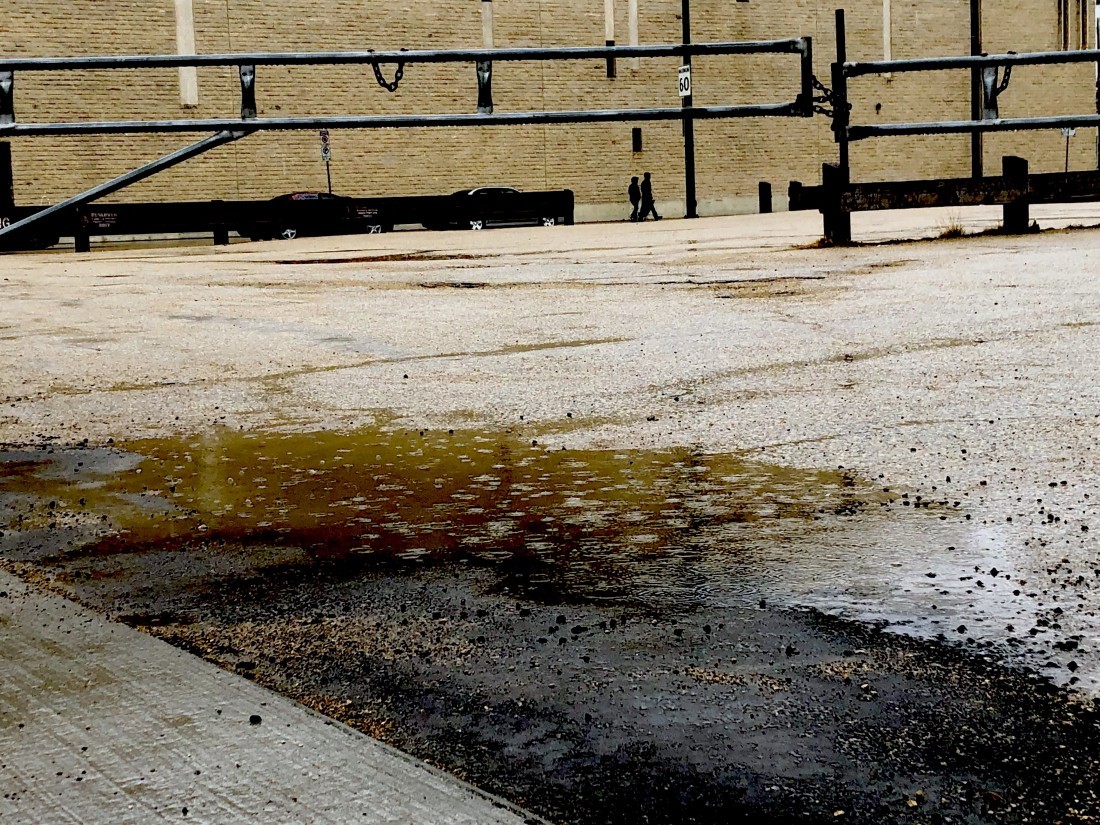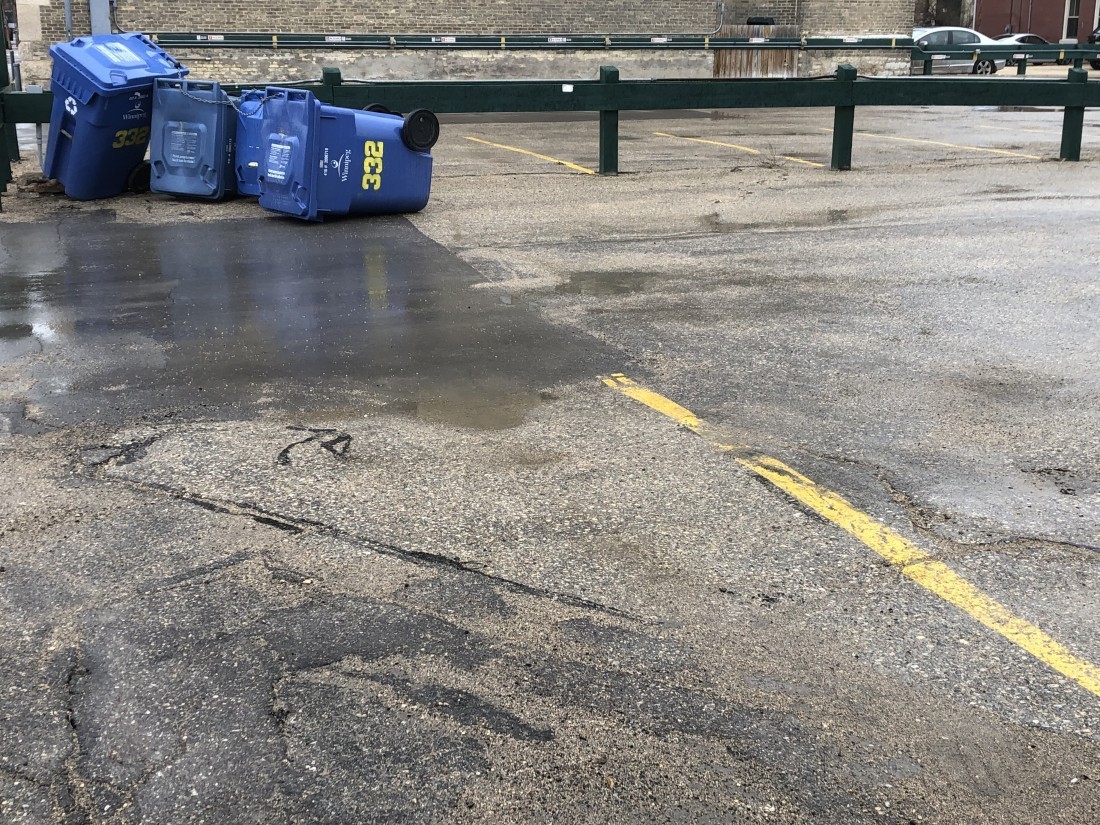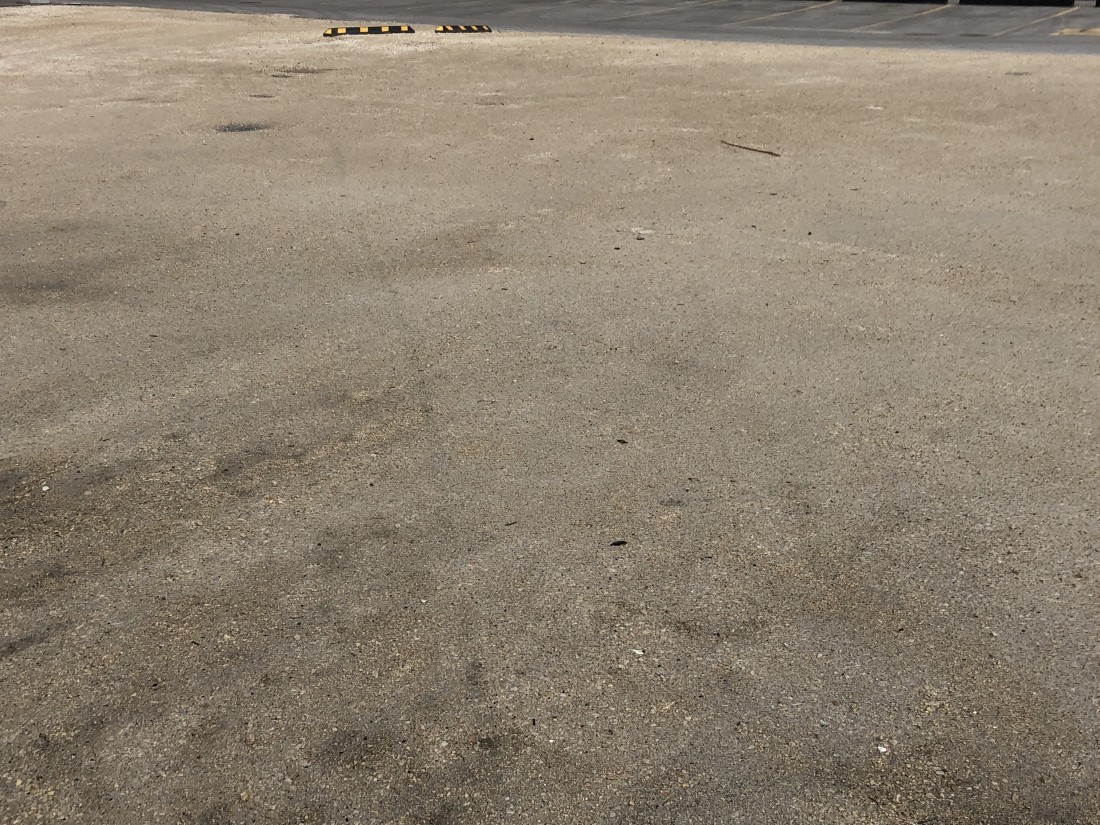Walking the Talk and Talking the Walk
Leave it to a philosopher to combine the peripatetic with musing. A combination of mobility and inspiration led Jeanne Randolph to her most recent project, “Parking Lot Pandemic.” “I was taking a walk and I saw a particular nearby parking lot,” she says. “I think I was hit by the muse.” What she experienced was a hit-and-fun accident. The muse in this case occasioned a realization that the empty parking lot was a symptom and a sign of how the city and its things and spaces were beginning to change.
If, for Paul Klee, drawing was taking a line for a walk, then walking for Jeanne Randolph is taking an idea for a meander. The generative idea in “Parking Lot Pandemic” is scale, how we perceive it and then how words and images alter those perceptions. Her measure engages both the immense and the tiny; text and photographs are the tools for that calibration. The opening sentences list immensities: oceans, the sky over Saskatchewan, the Grand Canyon. “Facing these monumental wonders you might judge your own size,” she writes. “You might say, ‘I am tiny.’” She does say that, but what her photographs say even more convincingly is that “space is big.”

Jeanne Randolph, “Parking Lot Pandemic,” 2020, inkjet on Epson Premium Luster paper. Courtesy the artist and Paul Petro Contemporary Art, Toronto.
One of the ways she conveys that sense of proportion is by emphasizing the foreground in her photographs. In one, a pair of black and yellow markers look like tiny caterpillars crawling across a parking lot surface that takes up all but a fraction of the image; in another, clumps of dirt, gravel and water splashings carry more visual weight than the two miniaturized people walking along the top of the photograph. In the essay’s penultimate image, what draws our attention is a crumpled, empty case of Molson’s beer in the lower left-hand corner. The turquoise 24-pack is the only colour in an image in which the surface of the parking lot is a flat, monochromatic grey and the wall of the building beyond is a pale, washed-out yellow.
In another photograph, Randolph shows an empty parking lot with a reddish ground, framed by a building in which a dominant green wall on the left meets an adjoining wall vectoring to the right. Two small rectangular signs in the same pale green are visible at the centre of the image. The photograph uses this formal frame to connect to the virus. Her text refers to “wee viruses with intricate geometric shapes,” and her photographs establish spatial relationships through those kinds of shapes. “I always think about imagery when I think about text,” Randolph says. “The two of them are in a dialogue with each other in such a way that you don’t really enjoy one, or get frustrated by one, either way, unless you go back and forth between what you read and what you see.”

Jeanne Randolph, “Parking Lot Pandemic,” 2020, inkjet on Epson Premium Luster paper. Courtesy the artist and Paul Petro Contemporary Art, Toronto.
Consider the shifting apprehensions and scales in this paragraph: “When compared to the Grand Canyon, however, a virus is a rather simple entity. Compared to a Luna Moth coronavirus is rather simple. It is so simple you might say it is immensely simple, in the same sense you might say the sun is so bright its brilliance is immense.” All her language here plays inside space; even the species of moth connects us to the sky. When she moves her attention from our sun to the zillions of dazzling stars in the universe, her measure is an imponderance. This time she appropriates an idea from Disney’s universe: “It seems we are making wishes on fireflies at the edge of a black hole.”
That’s one scale. At the same time tininess is everywhere: in pixies, snowflakes, the twinkling of stars, baby feet and germs. It is this last miniscule thing that opens up the space of her inquiry to the coronavirus. When she mentions “the biggest virus yet,” she takes us into Blake’s “Auguries of Innocence,” where he sees “a world in a grain of sand”; her pandemic vagaries of experience imagine the Megavirus, “so tiny that millions of them could march on a pin.” Randolph acknowledges her propensity to animate small creatures: “I am intrigued by the idea that these tiny, tiny creatures, even viruses or germs, are not quite classified as living animals. It goes against the grain to portray something as tiny as a virus or an aphid as having their place and their consciousness in our everyday life. We seldom sympathize with these nasty little beings.”

Jeanne Randolph, “Parking Lot Pandemic,” 2020, inkjet on Epson Premium Luster paper. Courtesy the artist and Paul Petro Contemporary Art, Toronto.
What intrigues her about the coronavirus is its invisibility. “We made an immediate transition when we realized we were threatened by something we couldn’t see, by a virus that we’d never even heard of,” she says. As it turns out, what she allows us to see through her photographs plays a significant role in “Parking Lot Pandemic.” “My mind is photographic. When I write, I just copy the picture in my mind.” The selection and placement of her mind-pictures are extremely effective. For the most part, her palette has been minimal and close-valued, moving toward the monochromatic. In the last three images she makes some subtle colour adjustments: one image includes a spot of red junk in what is essentially an empty photograph; then the turquoise cardboard beer case; and, finally, an image of three, tipped-over, radiant blue dumpsters, one of which has bright yellow numbers. Randolph sees the colour shift as another opposition: “Just as things have been so empty and almost monochrome, there’s an excitement or an optimism in the types of colours that round it off. This is all dire and mixed up; we get all these happy colours as the thing comes to an end. Again, it’s another juxtaposition, another contradiction. How can celebration and emptiness go together?” ❚

